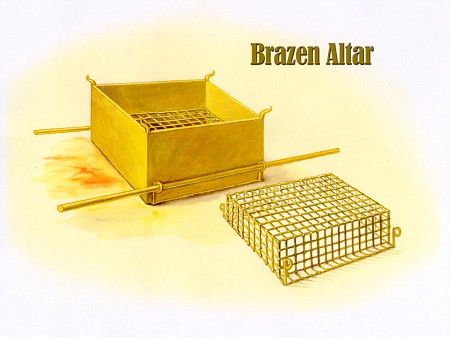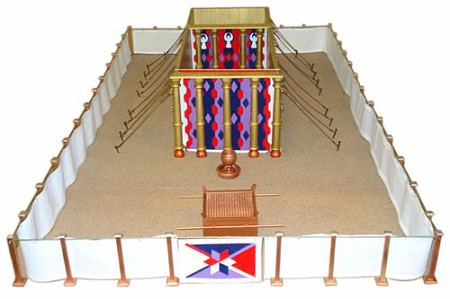Exodus Chapter 27
Review: In Chapter 25, The Lord met with Moses on the mountaintop of Mt. Sinai and gave him detailed instructions regarding the ark, mercy seat, table, and lampstand. In chapter 26, the instructions continue with the materials and construction of the tabernacle itself. Remember as we read these details, we are also looking at the tabernacle as a pattern or representation of heaven. (Hebrews 8:5) As we continue to look at the tabernacle details, we will see spiritual truths of the Lord Jesus in the heavens as our High Priest. Amen.
Exodus Chapter 27
The Bronze Altar For Burnt Offerings
1. What was the altar to be made out of? vs. 1
2. What was the size of the altar to be? vs. 1 .... did you find the conversion of the cubits?
3. They were to make 4 horns on the 4 corners of the altar, made of one piece. What were they to overlay it with? vs. 2
4. Pails were to be made for removing the ashes. The pails along with the shovels, basins, forks, and firepans along with all the utensils were to be made of bronze. (vs.3) They were also to make a grate of netted bronze and make 4 bronze rings at its four corners. (vs.4) They were to put it under the ledge of the altar so that it would reach halfway up to the altar. (vs.5)... and then make poles for altar of acacia wood overlaid with bronze. (v.6) The poles were to be inserted in the rings so that the poles would be on the 2 sides of the altar when it is carried. (vs.7) How were they to make the altar inside and what was Moses to be careful he followed? vs. 8
Note: We will see the purpose of the bronze altar of sacrifice fully in the book of Leviticus. The horns on the 4 corners were to bind the sacrifice (the animal) to the altar.(Psalm 118:27). Let's take time to look up some verses concerning the burnt offerings that were to be made on this altar of sacrifice.
5. When were offerings to be made?
- Exodus 29:38-42
- Numbers 28:3,6
- 2 Chronicles 2:4
6. When was an additional burnt offering to be made?
- Numbers 28:9-10
- Numbers 28:11
- Numbers 28:16
- Numbers 28:27
- Numbers 29:1
- Numbers 29:6
Note: The purpose of the burnt offering was to make atonement for the sin of the one who offered it in order to gain God's acceptance. The person laid their hands upon the animal as to transfer the guilt of sin to the innocent animal. It was very much a picture of what Christ did for us on Calvary, taking our sin upon HImself. It was a required offering, not for a particular sin that was confessed, but for the person in a sinful state before a holy God; his sin had to be atoned for continually.
7. Why is it not necessary for us to do this today as a believer in Jesus? Comment on the verses given.
- Hebrews 10:1-14
The Outer Courtyard
8. What were they to make to hang on the south side of the court? vs. 9
9. What were these to be made of? vs. 9
10. What were the measurements to be? vs. 9
11. There were pillars to go between the hangings. How many were there? vs. 10
12. What were they to make to hang on the north side of the court? vs. 11
13. These were the same measurements and fabric as the other. How many pillars were on this side as well? vs. 11
14. For the width of the court, what was the measurement of the hangings on the west side? vs. 12
15. How many pillars divided these hangings on the west side? vs. 12
16. In like manner, was was the measurement of the hangings on the east side? vs. 13
17. How many pillars divided these hangings on the east side? vs. 14
18. What were the measurements of the hangings for the GATE on the east side to be? vs. 15
19. How many pillars did the gate have to connect the hangings? vs. 15
20. What was different about the fabric of the screen for the gate of the court? vs.16
21. What were the colors of the fabric? vs. 16
22. How many pillars were there to connect the hangings for the gate? vs. 16
23. What did all the pillars around the court have on them? vs. 17
24. What was the length of the court? vs. 18
25. What was the width of the court? vs. 18
26. What was the height of the court? vs. 18
Note: The rectangular court was surrounded by a large linen fence, with pillars every three cubits. At one end was a single gate, the material being the same blue, purple and scarlet color as the two veils.
27. What were all the utensils used in the court to be made of? vs. 19
The Golden Lampstand

28. What kind of oil did Moses charge the sons of Israel to bring to him? vs. 20
29. How often was the lamp in the holy place to burn? vs. 20
Note: The lampstand was to have clear oil of beaten olives as a fuel source. It would be the priests' duty to maintain the oil, keeping the light going.
30. Who kept charge of the tent of meeting outside the veil that was before the testimony? vs.21
31. How often were they to keep charge of it? vs. 21
32. How long was this be a statute in Israel? vs. 21
Note: In overview, the tabernacle would be a tent - a moveable structure. God wanted Israel to know He would be with them, wherever they went. It wasn't a "You come to Me," but "I have come to You". "The Hebrews were meant to feel that the God of their fathers was a fellow-pilgrim, that where they pitched He pitched, that their enemies, difficulties, and long toilsome marches were His." (Meyer)
Application:
33. Jesus is our burnt offering and God is well pleased for us now to enter the Holy of Holies through HIs blood and sacrifice. Are you entering daily to minister to the Lord?
34. Jesus walks among the lampstands in Revelation. The lampstands are the 7 Spirits of God sent out into all the world. The priests were to see that the oil never ran out and the lamps never burned out. How does this compare to us being the light of the world and the need for the oil of the Holy Spirit to continually burn within us?
35. Summarize the chapter and post a prayer if you would like.
In chapters 28-30, we will pick up the pace a little and see the garments and consecration of the priests, as well as the two final pieces of the tabernacle, the altar of incense and the bronze laver.



No comments:
Post a Comment